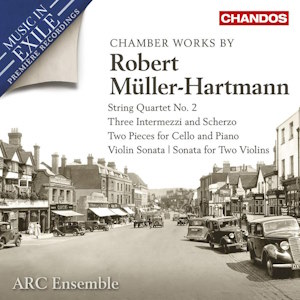
Robert Müller-Hartmann (1884-1950)
Violin Sonata, Op.5 (c. 1923)
Two Pieces for cello and piano (before 1937)
Sonata for two violins (c.1935)
Three Intermezzi and Scherzo, Op.22 (before 1937)
String Quartet No.2, Op.38 (before 1937)
ARC Ensemble
rec. 2022, Koerner Hall, TELUS Centre for Performance and Learning, Royal Conservatory of Music, Toronto, Canada
Chandos CHAN20294 [69]
Robert Müller-Hartmann was born in Hamburg in 1884 and was a second cousin of Paul Dessau. He attended the Stern Conservatory in Berlin where he was taught by the Brahmsian Eduard Behm and went on to compose widely and to teach. His orchestral music was programmed by Karl Muck, Carl Schuricht, Fritz Busch and Otto Klemperer, who had also studied at the Stern Conservatory. Even Strauss conducted his music, the Symphonic Overture, Op.7, in Berlin in 1917. Müller-Hartmann became increasingly marginalised in Germany and in 1937 left for Dorking in England where he struck up a friendship with Vaughan Williams, who then also lived in Dorking, and was characteristically generous in finding work for him.
All the pieces in this ‘Music in Exile’ series are première recordings and date from Müller-Hartmann’s German years. The Violin Sonata was dedicated to Artur Schnabel who premiered it in 1923 with Heinrich Bandler, concertmaster of the Hamburg Philharmonic. It’s cast in three equally-sized movements and is somewhat Franco-Belgian in orientation though Müller-Hartmann was strongly rooted in Austro-German romanticism. There are also vague Delian elements at work, though doubtless refracted through this French leaning, and a strongly rhapsodic profile. The central movement has an elevated, rather noble theme and is sensibly developed, whilst the finale is solidly traditional in the Franckian sense. Erika Raum of the ARC Ensemble is the sensitive violinist with the ensemble’s Kevin Ahfat taking on the Schnabel role.
The String Quartet No.2 was composed some time before 1937 and is the other large-scale chamber work in the programme. It shares with the Sonata an unhurried lyricism and a sense of fluidity that ensures the music is properly bound together. The crispness of the Scherzo contrasts with the smaller size of the Adagio which nevertheless shows the composer’s facility with compressed expression. The fugato in the finale is not over-done and emerges that much more elegantly as a result. I can’t pretend that the Quartet shows overmuch personality but it is very competently laid out.
Of more vitality is the Sonata for two violins where Raum is joined by her colleague Marie Bérard. Dating from around 1935, it’s a classically-conceived, emollient four-movement piece of some charm with hints of folklore and where the fiddles flit after each other like butterflies, iridescent in the afternoon sunshine. Zesty and witty it would make a good concert contrast with Alan Rawsthorne’s much grittier Theme and Variations for two violins of 1937. The Three Intermezzi and Scherzo for piano offer a Brahmsian trio topped by a fresh-faced Scherzo with its own striding, sturdy Brahmsian theme in the B section. The Two Pieces for cello and piano would work adeptly in recital, the melancholy of the former and the more fluid, faster elements of the latter showing flair.
The ARC Ensemble seem to get to the heart of these pieces and present them in sympathetic performances in a good acoustic. The notes are by Simon Wynberg and go into far more biographical detail than I have time for here and are well worth reading in detail.
Great music? No. An interesting rediscovery reflective of traditional elements in inter-war Germany? Yes.
Jonathan Woolf
Help us financially by purchasing from





















